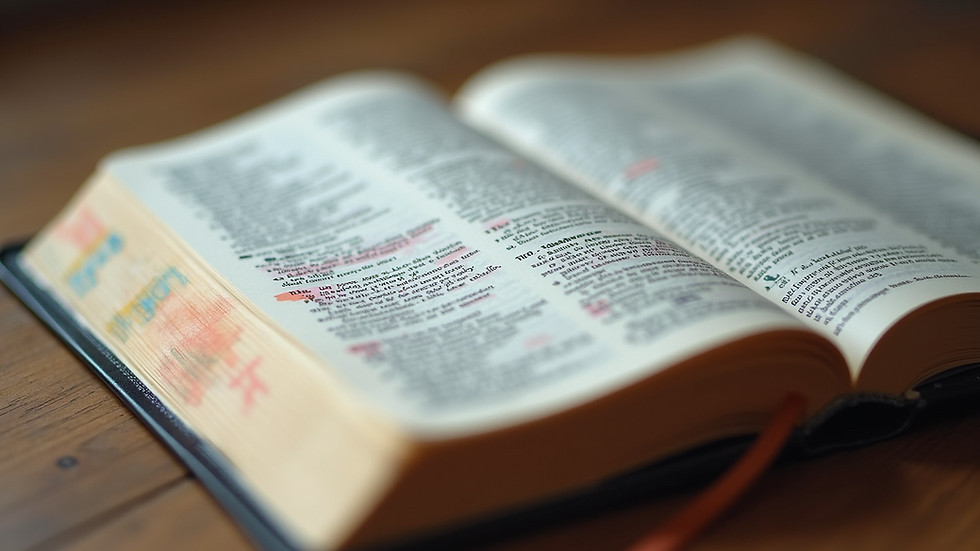Determining the Ideal Bible Font Size Across Different Age Groups
- Joy Creative Bibles

- Apr 25
- 4 min read
Finding the right Bible font size is very important for improving readability and comprehension. As people get older, their vision usually changes, which impacts how they read printed materials, including sacred texts. This guide studies the font size preferences of different age groups, aiming to help readers make better choices for personal use or gift-giving.
Understanding Age-Related Vision Changes
It is critical to understand that vision changes over time. Younger people generally see clearly and can read smaller fonts without difficulty. However, around the age of 40, many individuals start experiencing presbyopia, a common condition that makes small text more challenging to read.
Font size goes beyond personal choice; it directly affects how comfortable a reader feels and how well they can engage with the text. Understanding these factors will help you select a Bible that communicates its message effectively and is suited to its audience.
Children and Young Readers (Ages 5-12)
For early readers, a larger font size is crucial. Aim for a font size of at least 14-16 points to help children follow words easily. Many children’s Bibles feature bright illustrations and larger typefaces, making reading fun and accessible. For instance, a Bible published by a major publisher like Zondervan often uses a 16-point font combined with engaging visuals.
Clear text supports a child’s ability to develop reading skills. Research shows that children who can easily see and decode text are more likely to enjoy reading. This early exposure can instill a love for stories and lessons found in the Bible, often encouraging them to return to it throughout their lives.
Teenagers and Young Adults (Ages 13-25)
Teenagers and young adults often do not need as large a font size as children. A font size of 11-13 points generally meets the needs of this group. At this age, reading often connects with personal style; many young adults favor modern Bible formats that blend good typography with aesthetic appeal. For instance, the New Living Translation (NLT) has editions that are highly designed, featuring sizes between 11 and 12 points, catering to this demographic.
Visibility remains essential because young adults frequently read in various lighting conditions, making visual comfort a top priority. Selecting Bibles with diverse font styles can capture their interest and stimulate deeper engagement with their studies.
Adults and Middle-aged Readers (Ages 26-55)
As adults navigate their 30s and beyond, they're more likely to begin experiencing presbyopia. Most adults in this age range prefer a font size of 10-12 points, but their comfort levels can vary. Consider the various reading contexts adults find themselves in, whether it's in a study group, private reflection, or during teaching sessions.
A well-designed Bible—one that balances a clear font with an appealing style—can enhance understanding and retention, particularly in group discussions. Various sources reveal that many adults choose Bibles with added features such as study notes or guides, which can enrich their reading experience. Choosing a size that is easy to read can foster greater engagement during these sessions.
Seniors and Elderly Readers (Ages 56 and Above)
For seniors, visibility often becomes a major concern. With presbyopia and other age-related vision challenges, larger font sizes become necessary. A font size of 14-18 points is typically most suitable for this group. Many Bibles designed for older adults use larger typefaces and may include high-contrast color schemes, which enhance readability. For example, editions from publishers like Thomas Nelson often fit this model.
When choosing a Bible for elderly readers, also consider features like paper quality and text contrast—dark print on light backgrounds enhances legibility. Additionally, a layout with sufficient line spacing prevents text from feeling cramped, making it easier for seniors to follow along without losing their place.
The Importance of Font Style
Font style plays a vital role in readability, alongside size. Fonts that are sans-serif or have a straightforward design typically minimize eye strain. More stylized fonts can be challenging for readers, especially in smaller sizes.
Moreover, factors such as line spacing and margins significantly enhance the reading experience. Bibles with adequate line spacing help readers track lines of text smoothly, avoiding confusion.
Final Thoughts on Choosing the Right Font Size
Selecting the ideal Bible font size for various age groups involves careful thought about the changing vision needs throughout life. Young children thrive on larger fonts for greater engagement, while teenagers and young adults look for clarity combined with style. Adults should choose sizes that optimize their reading in diverse settings, and seniors need larger fonts along with improved layouts to ensure readability.
Dedicate time to finding a Bible with a suitable font size. This not only enhances the reading experience but also shows a thoughtful consideration for the reader's needs. Whether for personal use or as a special gift, addressing these factors can make a substantial difference in someone's spiritual journey.

By being attentive to the recommended font sizes for each age group, individuals can enhance their connection with scripture, fostering understanding and wisdom in their spiritual lives.



Comments